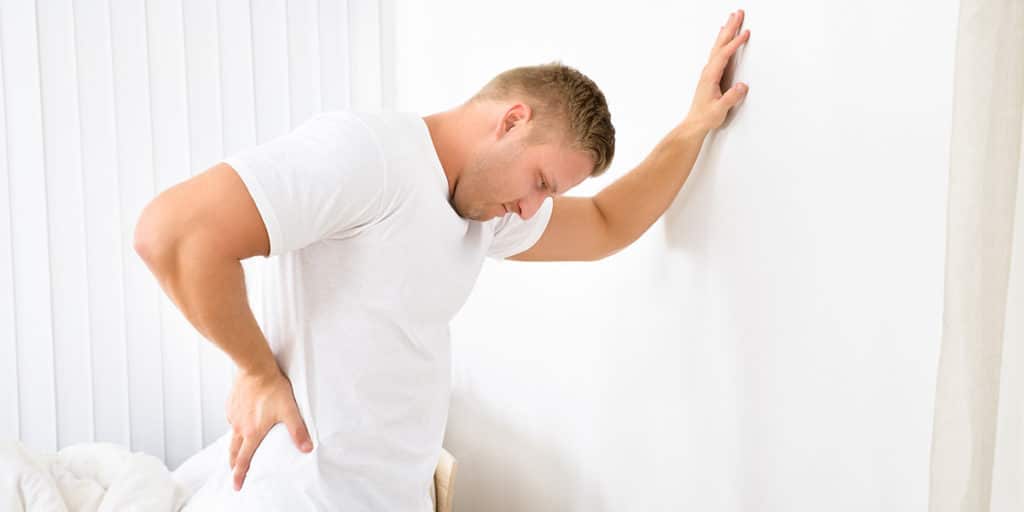Leading Cause of Back Pain Today Can Be Relieved Naturally
Back spasms are one of the leading causes of back pain, and the first step to pain relief is understanding the problem. Read on to discover if muscle spasms may be the cause for your back pain, how to prevent your next back spasm, and self-care strategies for relieving the pain naturally and quickly using methods like Inverted Decompression.
What Causes Back Spasms and Cramps?
Back spasms are a natural and protective response to any kind of overuse or injury to a muscle and involve abrupt, painful, and involuntary contractions of the muscle fibers. These often occur in cycles of contractions and bulging of tight muscles, a signal telling you to slow down or stop what you are doing. Back spasms can be triggered by a wide range of issues, from muscle, tendon, or ligament injuries to more serious medical conditions.
Some of the more common causes of back spasms include:
- Overtired, overstretched, and overworked muscles
- Muscles held in the same position for a long period
- Excessive strain due to heavy lifting
- Activities that demand the back turn suddenly and repeatedly, for example playing golf.
Sometimes back muscle spasms and cramps can signal there is an underlying anatomical problem in the spine. More serious spinal conditions can cause inflammation of the surrounding soft tissues which can trigger muscles to cramp or spasm. Examples of these more serious conditions causing muscle spasms include:

How to Relieve & Prevent Muscle Spasms
The best solution for back spasms is prevention. Proper hydration and nutrition play a big part in prevention. Maintaining a regular intake of water and incorporating more foods high in magnesium and calcium helps your body manage a good electrolyte balance to help stop cramps before they start.
Stretching before activities also benefits the muscles and may minimize spasms. While there is no one exact cause of muscle spasms, some researchers believe that “a regular program of stretching lengthens muscle fibers so they can contract and tighten more vigorously when you exercise.”1
If you are already experiencing muscle spasms, immediate gentle stretching can help to break the back spasm cycle. Using a cold compress for the first 72 hours will reduce swelling. Applying heat after 72 hours will help the muscles repair and release tension.
Continue with normal daily activity as much as possible. Bed rest can make your muscles stiff, causing more pain. Massaging the area or taking an Epsom salt bath can also help to relieve the tension from a muscle spasm.
More aggressive solutions for back spasms include medications, physical therapy, acupuncture, and chiropractic care. Because some of the more aggressive options for back spasms can be expensive, time-consuming, and invasive, more Americans are turning towards natural and lower-cost alternatives like Inverted Decompression (also called Inversion Therapy).

How Inverted Decompression Can Help Back Pain from Muscle Spasms
Inverted Decompression is a natural form of traction that utilizes your body weight in combination with gravity to elongate the spine and reduce pressure in the discs. Using an Inversion Table from Teeter, you’ll be able to take advantage of the same gravitational force that compresses your spine every day while upright and convert that energy into relieving pressure. Medical studies show this type of therapy “seems to separate the vertebrae, remove pressure or contact forces from injured tissue, increase peripheral circulation by a massage effect, and reduce muscle spasm.”5
Inversion therapy allows you to easily and actively stretch deep, hard-to-reach muscles that support your spine, a stretch that is “beneficial in reducing extrinsic muscle guarding and spasms” according to the Journal of Orthopedic & Sports Physical Therapy.2 One study concluded that the explanation for the positive effects achieved by inversion therapy is due to the “stretching of the muscles and ligaments.”3 This is especially true for muscle spasms in the lower region of the back, an area that is hard to stretch and endures much compression from normal daily activities each day.
How a Teeter Works to Relieve Back Pain
Keeping back muscles elastic and free of tension contributes to overall spinal health, fluidity of movement, and reduced risk of back spasms. Notably, one study measured a remarkable 35% reduction in EMG activity (a measurement of muscle tension and pain) after participants were inverted for just 10 seconds! Researchers noted a correlation between a reduction in EMG and an increase in spinal length4. This increase in spinal length is only possible to achieve in your own home using an inversion table.
One of the most amazing things about inversion therapy is how easy it is to incorporate it into a regular schedule. Just a few short minutes a day can keep your spine healthy, your muscles elastic, and your back tension free. A maintenance program that is simple to follow ensures long-lasting benefits and a future free from back pain!
Find Relief Now. Pay Later.
Now you can try Teeter in your own home FREE for 30-Days, 0% APR* with Affirm.
